Doubting Thomas

Cue up the ESPN “30 for 30” disembodied voice…
“What if I told you <pause>that a perennial fantasy beast has seen his value decreased. Dynasty League Football wants to know<pause> why people are <pause> doubting Thomas?”
Dramatics notwithstanding, the word picture I’ll now attempt to paint for you is one worthy of at least a small bit of theatrics. Perhaps an episode of Unsolved Mysteries, if nothing else? Because for the life of me, I cannot understand the circumstances surrounding the current devaluation of erstwhile dynasty WR1, Demaryius Thomas.
[am4show have=’g1;’ guest_error=’sub_message’ user_error=’sub_message’ ]
To start things off, there hasn’t been been a more consistent fantasy receiver over the course of the past four years. During that time, Thomas finished as the PPR WR5, WR1, WR2, and most recently the WR9 in 2015, despite a down year for the Denver offense (more on that later). In fact, be it due to injuries or down seasons, no other receiver in the game right now can boast this type of unfailing excellence.
And yet, according to the DLF rankings, he’s barely hanging on as a WR1, checking in as the overall WR12. Three of the seven rankers have him rated as a WR2, and only yours truly has him in the single digits (WR8). For a recently-turned 28-year old pass catcher still in the prime of his career, this seems unfathomable.
Perhaps the best place to start when seeking an explanation is with a postmortem analysis of his 2015 season, by viewing it in a week-to-week manner. To that end, I did the same thing not terribly long ago in my breakdown of Allen Robinson, utilizing my long-established AIR Metric to detail how the young receiver performed within the scope of his offense. I now want to place the same microscope on Thomas, and see what he brought to the Broncos’ table.
As a reminder, the AIR metric essentially evaluates the relation between a receiver’s proportion of his team’s PPR points and his target share. If he achieves expectations, this ratio should hover right at 1.00, with transcendent and inefficient play resulting in higher and lower values, respectively. Given the greater fluctuation of one-week time points, I’ll again use the following grading rubric:
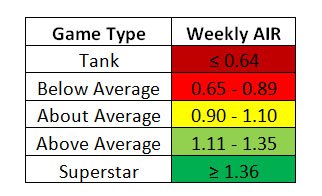
With that in mind, let’s take a look at Thomas’ season that was:
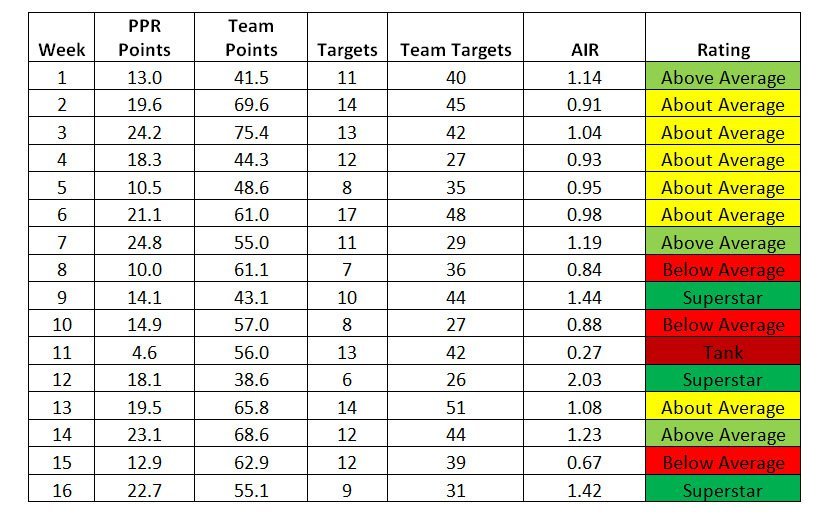
While that’s more yellow and red than I’d prefer to see, the end results paint a relatively flattering portrait. Thomas achieved at least average production 75 percent of the time, and even two of his three “below average” games just missed missed out on the “about average” tier. He also only tanked one week, a sorry affair versus the Patriots when he only managed to corral one of his 13 targets.
Continuing, even though he scored 67.5 fewer PPR points in 2015 than he did last season, he was actually meeting expectations more often, something he did only nine times in 2014 (56.9 percent of average or better performances). He also had two additional “superstar” games, and two fewer “tank” performances. So even though the aggregate points didn’t follow suit, Thomas was, in my opinion, even better this year, and less target dependent.
His seasonal AIR value of 1.03 doesn’t blow minds, but if you factor out that miserable performance against New England it actually jumps to 1.07. Even if I remove his highest seasonal output (week 7) on top of that, his average remains at 1.06, easily besting his 2014 AIR score of 1.00.While not elite by any stretch of the imagination, it proves Thomas did more with his targets than he did a year ago.
All told though, metrics don’t win fantasy games – points do. Fortunately, Thomas did that more than often enough, leading to starting-caliber viability nearly each and every week, as can be seen in the table below:
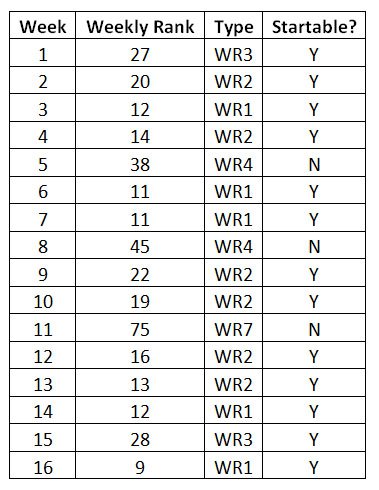
Assuming your league starts at least three receivers, which seems like a fair assessment in today’s fantasy landscape, Thomas was at least a PPR WR3 or better 13 times (81.2 percent). In deeper leagues with four receivers, or a FLEX position, Thomas was a startable asset 15 times (93.8 percent). He only truly screwed the pooch once, and was a top-15 guy on seven occasions (43.4 percent) – his ceiling wasn’t what we saw previously, but his floor remained high.
While the AIR evaluations and weekly finishes tell us how Thomas performed, we still need to rationalize why things went down as they did. As alluded to earlier, the offense as a whole took a massive step backwards – one year after providing 1,116.9 points to their pass catchers, the Broncos quarterbacks could only muster 903.6 points in 2015. This included approximately 500 fewer yards, 31 less receptions and less than half of the touchdowns (19 versus 40). Given the aggregate of this relative ineptitude, it’s not surprising Thomas fell slightly off his former pace as it relates to the yearly PPR hierarchy.
Part of this stemmed from the play design for whoever was lining up under center. Be it Peyton Manning’s noodle arm or Brock Osweiler’s inability to push the ball downfield, the numbers show Thomas wasn’t utilized as he had been previously. To that end, consider the breakdown of his receptions over the past four seasons:

While he’s never been quite the deep threat his size and speed would suggest, Thomas hit a four-year low with only 4.8 percent of his receptions traveling at least 20 yards in the air. Conversely, he had the second-highest percentage of his receptions travel under 10 yards in the air, including those behind the line of scrimmage – this stark contrast is suggestive of a player who was essentially tasked with creating his own yardage after the catch. As a maven in the open field, Thomas was able to do just that, with nearly 40 percent of his yardage coming after the point of reception. A perfect example of this occurred in a week 17 clash with the rival Chargers:
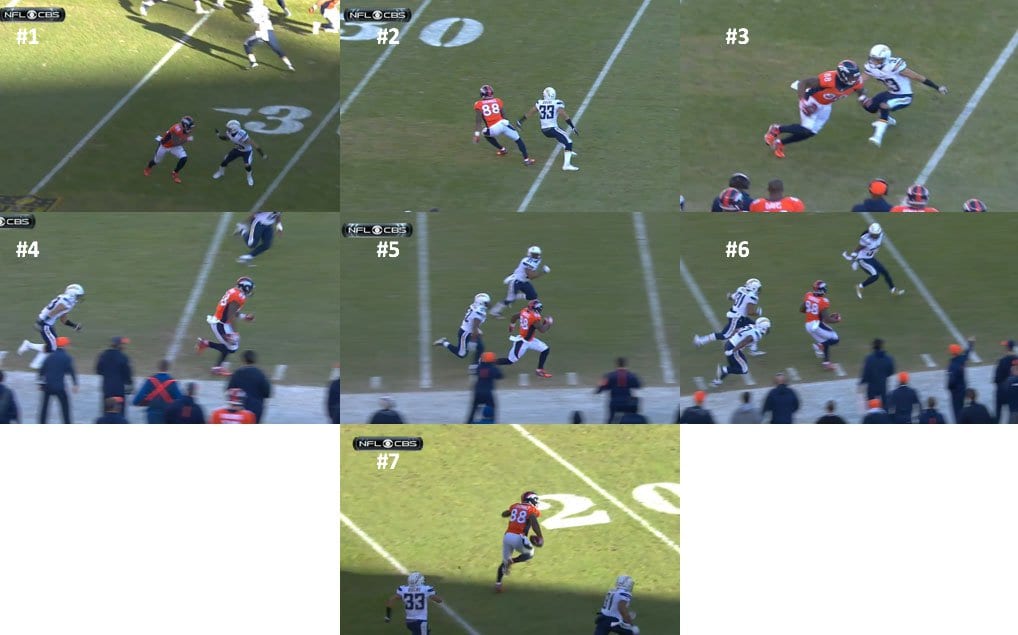
In the first two frames, Thomas gains space on a good comeback move, enabling him to keep separation when he turns upfield (#3). He blows away his coverage (#4), and subsequently defeats three more defenders (#5 and #6) on his way to the end zone (#7). Plays like this, even when they don’t result in a score, should continue to insulate Thomas even if his usage continues on its current trajectory.
Also adding to the challenge was the erratic accuracy of the Denver quarterbacks. With Manning a shell of his former self and Osweiler essentially a rookie in terms of game experience, the overall passing precision took a nosedive, hitting a four-year low dating back to 2012 (Manning’s first year in the Mile High City):
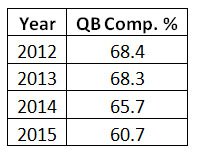
This scatter shot nature effectively curbed any possibility of another truly elite season, and resulted in numerous points being left on the field. A pair of prime examples occurred in the now oft-mentioned clash with the Patriots, helping explain why that weekly AIR score resulted in a tanking performance:
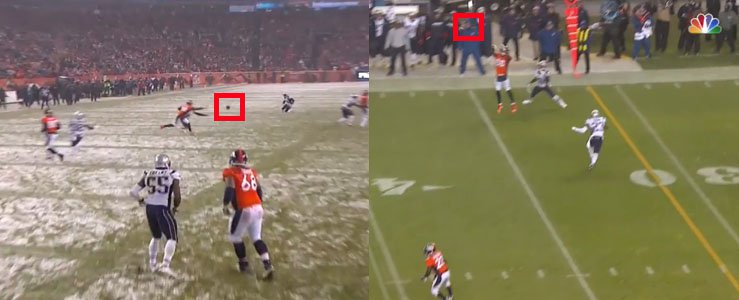
In the example on the left, Thomas wins his assignment, gaining position in front of the defensive back. The ball is placed about a yard out of his grasp (red box), lending no possibility to a productive result. In the play on the right, Osweiler’s pass is airmailed, with Thomas once again in position to make a play. It’s unlikely either would have resulted in movement after the catch, but that nevertheless erases two receptions and approximately 30 yards, robbing Thomas of an additional 5.0 PPR points.
When Denver did attempt to utilize Thomas downfield, the results weren’t any better. To illustrate that point, consider this play during the Broncos’ playoff contest with the Pittsburgh Steelers:
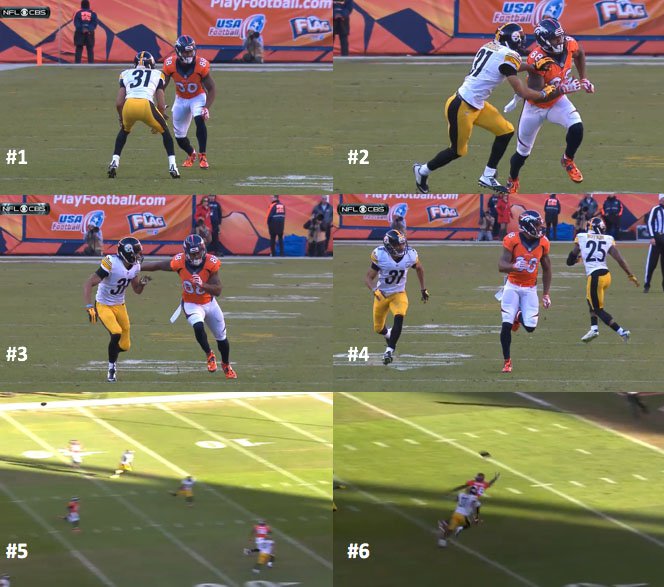
Tasked with beating press coverage (#1), Thomas blows by the jam (#2) and gains initial separation (#3). A slick inside move (#4) creates even more space, leaving Thomas streaking open down the field with the safety approximately 10 yards away from the action (#5). Unfortunately, the pass (this time from Manning) was off the mark, leaving the receiver with no chance to make the play. Even if the defensive back caught up (an even possibility in my mind, looking at the space between them with under 10 yards to the end zone), this should have turned into a long gain, with reasonable potential to result in a scoring play.
Of course, it’s not all sunshine and roses. Thomas’ alter ego, “Dropmaryius,” continues to make his presence known at inopportune times, culminating in nine unforced errors on the year. With 28 drops in the three years prior, this is unfortunately an established part of Thomas’ game, and something that will likely continue to frustrate owners for years to come. Circling back to that New England game one last time, it wasn’t always on the signal caller:

In this example, Thomas is lined up in the slot (#1), and finds himself wide open as his primary defender was on a blitzing assignment (#2). Osweiler finds him and puts the ball where it needs to be, only to see his star receiver fail to reel it in (#3). There were multiple Patriots defenders in the area, but it’s not out of the realm of possibility a big play could have been made, especially with three other Broncos in the picture for potential blocks, depending on where Thomas chose to go with the ball.
In this next example below, the ball was poorly thrown, but once again a play should have been made by an elite receiver:
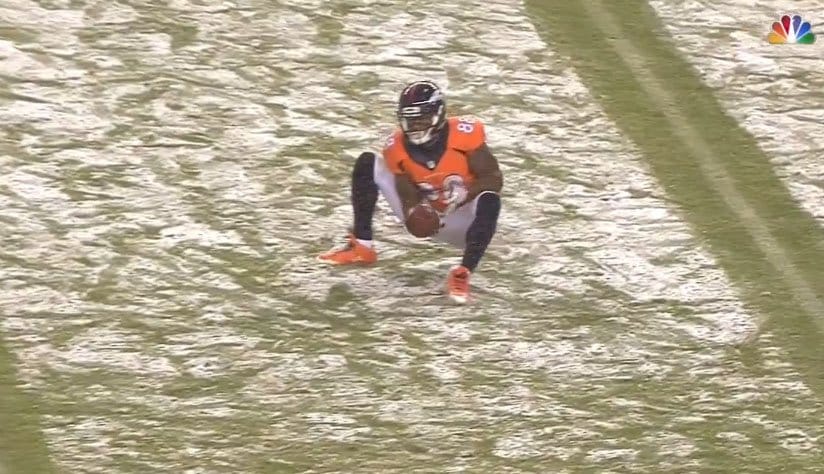
Due to ball placement this wouldn’t have resulted in any yards after the catch, but when fantasy contests can often times come down to a point or two, this reception still could have made a difference. Again, this is something that owners are no doubt used to by now, and it remains unlikely to be rectified in his seventh NFL season. But even with the drops, poor passes, diminished downfield utilization and wholesale offensive mediocrity, Thomas still managed to function as the same type of usage hog we’ve previously grown accustomed to seeing:

As can be gleaned from the table above, Thomas actually set four-year highs in the percentages of receptions and touchdowns he sequestered, while only securing a larger proportion of the team’s receiving yards in 2014. Yes, the team’s numbers were down, but Thomas still managed his fourth straight season of at least 1,300 yards, while also managing the second-highest reception total of his career. The biggest difference came in the form of the lack of touchdowns, but given his track record of scoring the ball, as well as his percentage of the team’s trips to the end zone, positive regression remains more likely than continued negative regression, or stagnation.
Given the totality of the above, I feel confident in saying Thomas was as good, if not better in 2015 than he’s been in his career. As mentioned numerous times, however, the offense was unexceptional, and there aren’t any guarantees it will be much better moving forward. It’s more than likely Manning won’t be back, and Osweiler is slated to hit the open market as well, though he could still be retained. If Denver brings in a new quarterback, how will the offensive design change, and can Thomas still function as the team’s unquestioned leading offensive weapon?

If the table overhead is any indication, that shouldn’t be a problem. Excluding a rookie season where he only received 39 looks, Thomas has been the team’s leading target on a per-game basis for the past five years. This has occurred over the course of four different quarterbacks, and more often than not there was an appreciable difference between Thomas and the team’s WR2. As I stated in my examination of Allen Robinson, volume often begets more volume, and it’s hard for me to believe that a potential fifth quarterback would act any different towards Thomas than the four shown above.
So given the entirety of the words, pictures and metrics provided in this space, I remain convinced that those who are doubting Thomas are over-complicating his place in the dynasty landscape. He’s still relatively young, proven over the course of multiple seasons, and scrutiny of the year that was helps prove that his 2015 “drop-off” was more rooted in myth than fact. If your league-mates are willing to sell for 80 cents on the dollar for the NFL’s shiny new toys at the position, you should be doing everything you can to acquire him at a discount. Because all told, while the dawning occurred years ago, we’re firmly still within the Age of Demaryius.
Follow me on Twitter @EDH_27
[/am4show]
- Dynasty Fantasy Football Mailbag: Is Kendre Miller Valued Unfairly? - April 17, 2024
- Forgotten Dynasty Veterans: Bottom Tier - April 9, 2024
- Dynasty Fantasy Football Mailbag: How Much Should You Factor in Off-Field Issues? - April 9, 2024


































































